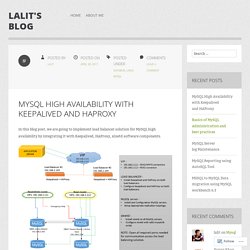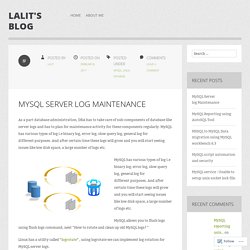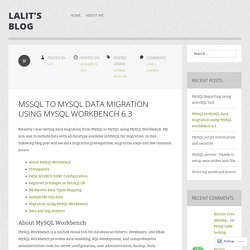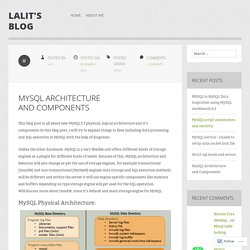

Indexes on Joins for MySQL. MySQL is simpler than the Oracle example because MySQL only has Nested Loops and doesn’t have Hash Join.

Here is the query, like on the Oracle example from the last blog post select max(t1.data) from t1, t2 where t1.id = t2.id and t1.clus = 1 ; So there are only 4 examples below which all do NL joins full table scan on T1 and T2 7.83 secsindex on T1 predicate filter column 7.39 secsindex on T2 join column 0.49 secsindex on both T2 join column and T1 predicate filter column 0.06 secs There isn’t an idea of “explain analyze” on MySQL until MySQL 8.0.18 and I did my testing on 8.0.17, so the explain plans costs are estimates not actual values, but the elasped time of the query is an actual value. Strange thing is that there are gaps in the sequence # in the seed table, thus the strange value in the truncate to get 106 values, i.e. truncate(id/169,0). First we run the query with no indexes ( I already created the indexes so force them off in the example with “USE INDEX()” ) "access_type": "ALL" Percona Server pour MySQL 5.7.20. MySQL Partitioning [Quick Overview] Quelques optimisations MySQL pour un Drupal 8 performant.
Que celui qui n'a jamais vu un serveur MySQL avec ses paramètres par défaut sur un serveur Quadri Coeur et 128 Go de RAM lève la main.

Il n'est pas rare que le serveur MySQL soit oublié à la mise en place d'un projet, Drupal 8 ou autres. Découvrons quelques paramètres de base à affiner selon votre environnement et votre projet pour booster les performances de votre site ou application Internet. Les valeurs indiquées ci-dessous sont bien entendu à ajuster en fonction de votre projet et des ressources disponibles sur votre serveur. Disons qu'elles peuvent constituer un minimum pour des performances sans commune mesure avec les paramètres par défaut.. A noter le cas particulier du paramètre innodb_log_file_size qui nécessite une procédure spécifique pour le changer A noter également que le paramètre innodb_file_per_table permettant de modifier le mode de stockage des bases de données et tables sur disque.
MySQL High Availability with Keepalived and HAProxy. In this blog post, we are going to implement load balancer solution for MySQL high availability by integrating it with Keepalived, HAProxy, xinetd software components.

High availability databases use an architecture that is designed to continue to function normally even when there are hardware or network failures within the system. Why we need this? Let’s take a scenario were we have MySQL Multi-Master / MASTER-SLAVE replication setup for high availability. In the case of Hardware/Network failure on MASTER, In order to failover to a next available server, we need to manually do the configuration changes for client connections.In this case, downtime is expected since manual failover will take some times.
To solve this we can integrate load balancer with MySQL to take care of this manual work and do automatic failover connections. Advantages: Load Balancer is a set of integrated software components that provide for balancing IP traffic across a set of real servers. Keepalive Configuration: Basics of MySQL Administration and best practices. MySQL Server log Maintenance. As a part database administration, DBA has to take care of sub-components of database like server logs and has to plan for maintenance activity for these components regularly.

MySQL has various types of log i.e binary log, error log, slow query log, general log for different purposes. And after certain time these logs will grow and you will start seeing issues like low disk space, a large number of logs etc. MSSQL to MySQL Data migration using MySQL workbench 6.3. MySQL Workbench Migration Wizard Report Source: Microsoft SQL Server 12.0.4100 Target: MySQL 5.7.15 -- Migration -- Summary Number of migrated schemas: 1.

MySQL Reporting using AutoSQL Tool. If you walk through any office you see people working in Excel.

With MySQL for Excel ( you can already let them pull information from Excel themselves. However, in some cases it saves a lot of time if they don’t have to pull the information, but it’s pushed automatically. Exception lists are the best examples of queries you want to push to users. If you have a query with occasional results, you don’t want to check for this every day. In this case you just want to receive a mail if there are any results. 1. The MySQL Event scheduler can be used to run a query on a predefined schedule and output the results in CSV format. Note that you can specify some formatting options of the file like the separator and the line terminator. Creating events in MySQL does requires the ‘EVENT’ privilege on the schema in which the event is created. MySQL Architecture and Components. This blog post is all about new MySQL 5.7 physical, logical architecture and it’s components.In this blog post, I will try to explain things in flow including data processing and SQL execution in MySQL with the help of diagrams.

Unlike the other databases ,MySQL is a very flexible and offers different kinds of storage engines as a plugin for different kinds of needs. Because of this, MySQL architecture and behavior will also change as per the use of storage engines, for example transactional [InnoDB] and non-transactional [MyISAM] engines data storage and SQL execution methods will be different and within the server it will use engine specific components like memory and buffers depending on type storage engine will get used for the SQL operation.